Installing PVC Panels Over Plasterboard? It’s Technically Possible
- Deen Gabriel

- 2 days ago
- 1 min read

PVC panels are lightweight and can be glued or screwed directly onto smooth surfaces like plasterboard.
This method is often used to refresh old ceilings without removing the existing material.
🚿 Bathrooms Require Extra Caution
Bathrooms are high-humidity environments, and moisture trapped between the plasterboard and PVC panels can lead to:
Mold and mildew growth
Peeling or bubbling of the skim coat
Structural damage over time
🛠️ How to Minimize Mold Risk
1. Ensure Proper Ventilation
Install or upgrade an extractor fan to reduce humidity.
Keep windows open during and after showers when possible.
2. Use Battens or Furring Strips
Instead of gluing panels directly, fix them to battens spaced below the ceiling.
This creates an air gap that allows moisture to escape and prevents condensation buildup.
3. Seal All Edges
Use waterproof silicone sealant around panel edges, especially near showers and sinks.
This prevents water ingress behind the panels.
4. Check for Existing Moisture
Before installation, inspect the plasterboard for signs of dampness or mold.
If present, resolve the issue first—don’t trap it behind PVC.
🧠 Final Thought
PVC panels are a great low-maintenance option for bathroom ceilings, but only if installed with moisture control in mind. Direct fixing over plasterboard is possible, but using battens and ensuring ventilation will dramatically reduce the risk of mold and extend the life of your ceiling.






Comments